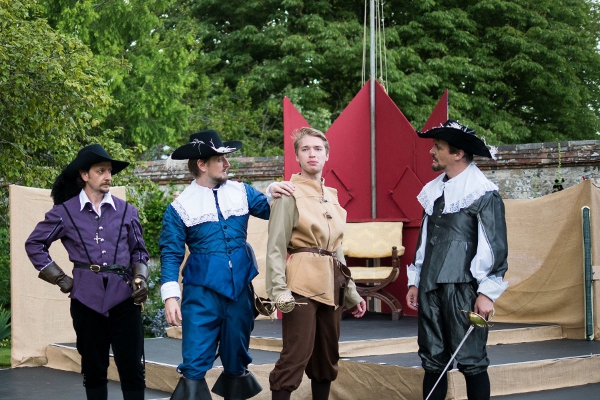The Three Musketeers
Information
- Date
- 8th July 2014
- Society
- Chesil Theatre (Winchester Dramatic Society)
- Venue
- Gardens of Wolvesey (The Bishop of Winchester’s Palace)
- Type of Production
- Play
- Director
- Martin Humphrey

With a large cast and plenty of action, The Three Musketeers needs a lot of space. The gardens of the Bishop’s palace fitted the bill admirably, with the palace itself (almost contemporary with the action) providing a fine back-drop. Peter Lidiard’s set consisted of a series of interlocked rostra, splaying out from a corner, backed by simple flats and, at the apex, a practical flagpole. The rostra were used for the various interior scenes, with the exterior scenes - mostly fights - played at ground level. An easel to one side of the stage carried a location title for each scene, but really this wasn’t necessary, with enough clues coming from the dialogue and the few essential items of furniture brought on by the actors or the costumed crew.
The script follows Dumas’s story faithfully (within the constraints of a reduction for the stage), so we see D’Artagnan (Michel Perlmutter) setting-out to join the King’s Musketeers and immediately getting tangled up in the power struggle between foppish King Louis (Michael Leckie) and Cardinal Richelieu (Peter Andrews) and the cardinal’s attempt to use the clandestine affair between the Queen and the Duke of Buckingham as leverage. (Incidentally, I was distracted by Buckingham describing himself as the Prime Minister. Did that anachronism come from Dumas?) The Cardinal and his henchman Rochefort (Andrew Tollyfield) are the villains of the piece - almost pantomime villains at times, although generally more competent particularly with the assistance of the sinister Milady de Winter (Sarah Andrews).
It is, of course, a romp, with the musketeers (Jim Glaister, Tez Cook and Alec Walters) carousing, womanising and fighting with all and sundry. A lot of effort had gone into the combat (directed and co-ordinated by Paul Benzing and David Baldwin), with action frequently breaking into several separate fights, sometimes overlaid with dialogue. A difficult area, since the audience will automatically compare the action to filmed fight sequences, for which the director has the opportunity of multiple takes. Martin Humphrey’s well-paced direction made excellent use of the venue, with the cardinal’s guards appearing from all directions to ambush Buckingham and the musketeers, and at one point a streak from Porthos. When actually being worn, the costumes were great, as were the hairstyles of the Queen (Rachel Waring) and her ladies (Eleanor Marsden and Rose Barslund) - no credit given in the programme, but plaudits to whoever was responsible. Good performances from the whole company, bringing out the romance, conflict, comedy and pathos.
A tremendous amount of planning and work had gone into the set-up. For an outdoor production, everything needs to be procured, transported and set-up. For example, someone has to find ways of powering a good 6KW of lights without blowing the fuses of the Bishop’s palace. The main acting area had boundary microphones stationed around the perimeter, each within a rain-proof miniature igloo. And indeed, protection from the rain was necessary: at the end of Act 1 the heavens opened, sending the audience dashing for the shelter of the trees. As the rain eased off, the puddles were swept off the rostra, and the audience returned to damp seats, but as soon as the action resumed no-one cared about the weather, swept along by the dash of the play.
© NODA CIO. All rights reserved.

 Show Reports
The Three Musketeers
Show Reports
The Three Musketeers